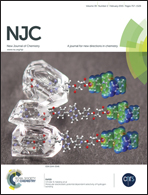Synthesis and characterization of a new family of energetic salts based on a guanidinium cation containing a picryl moiety†
Abstract
A new family of energetic salts based on a new guanidinium cation containing a picryl moiety, N-(2,4,6-trinitrobenzylideneamino)guanidinium cation, was synthesized and well characterized by IR and multinuclear NMR spectroscopy, differential scanning calorimetry (DSC), thermogravimetric analysis (TG) and elemental analysis. The structures of N-(2,4,6-trinitrobenzylideneamino)guanidinium nitrate (1) and N-(2,4,6-trinitrobenzylideneamino)guanidinium 5-nitrotetrazolate (5) were confirmed by single crystal X-ray diffraction. Most of the salts decompose at temperatures over 180 °C. Furthermore, except for the salts 1 and 9, most energetic salts exhibit low impact sensitivities (20–40 J), friction sensitivities (220–340 N), and are insensitive to electrostatics. The detonation pressure values calculated for the energetic salts 1 and 3–9 range from 23.7 to 30.3 GPa, and their detonation velocities range from 7842 to 8394 m s−1. These values indicate that some energetic salts can be candidates for energetic materials that possess good thermal stability and low sensitivity.


 Please wait while we load your content...
Please wait while we load your content...